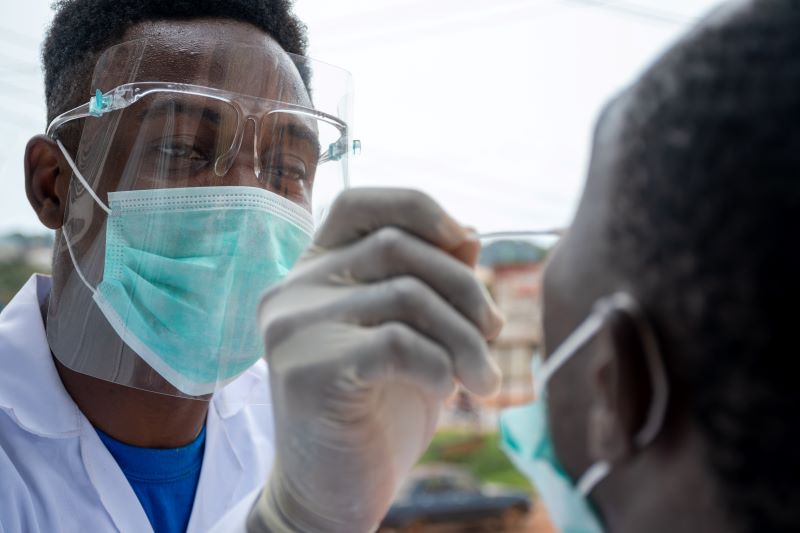Recommended

Blog Post

Blog Post
Africa continues to grapple with recurring disease outbreaks, with a total of 164 reported public health events in 2023 alone, including dengue fever, cholera, measles, yellow fever, m-pox, and chikungunya, among others. One critical question is: how can the Africa Centers for Disease Prevention and Control (Africa CDC), the autonomous, continental health institution of the African Union (AU), be empowered to effectively support member states in preventing, preparing for, and responding to diverse public health threats?
In February 2022, the African Heads of State and Government established the Africa Epidemics Fund (AfEF) to create a mechanism of funding to support preparedness and response efforts to combat public health threats. This decision, at the 35th Ordinary Session of the Assembly of the Union, was informed by the valuable lessons learned from the COVID-19 pandemic, mainly drawing lessons from the African Union COVID-19 Response Fund, (COVID Fund), which played a pivotal role in fostering a sense of solidarity and ownership in the continent's pandemic response efforts.
Setting the AfEF on a path to success is crucial to ensure sustainability and self-reliance in pandemic prevention, preparedness, and response (PPPR) across the African continent. This blog outlines key considerations regarding how the AEF raises and spends funds, underscoring the significance of a robust design and effective implementation at a time when the AfEF’s proposed governance and operational mechanisms are being deliberated on and presented to the AU policy organs for decision.
Key considerations on how the AfEF will raise funds
1. AU member states need to contribute to AfEF to secure ownership and sustainability
The AfEF offers a unique mechanism for enhancing the mobilization of domestic resources from the AU member states to enhance PPPR on the continent. It is worth noting that more than 40 percent of member states do not meet their yearly financial commitments to the AU. Therefore, through harnessing the momentum generated by the COVID Fund and learning from the experiences of the AU Peace Fund, the AfEF can play a pivotal role in facilitating ongoing financial support from AU member states for critical initiatives, thereby strengthening Africa's resilience and capacity to address public health threats. This concerted effort would strengthen the continent's ability to respond to crises and underscore the power of solidarity among AU member states in driving sustainable action to ensure Africa’s health security. In doing so, the AfEF can serve as a beacon of hope and collaboration for the entire African continent. In supporting the AfEF agenda, AU member states must be bold and embrace non-traditional, innovative financing mechanisms that can harness substantial funds for pandemic PPR in the continent.
2. The AfEF must engage Heads of State and Government and leverage the replenishment model
Leveraging recent changes in Africa CDC’s governance arrangements is essential for the AfEF to succeed. Among these notable changes is the inclusion of ten Heads of State and Government to the Africa CDC's governance under the Committee of Heads of State and Government. This elevated governance framework ensures top-level political leadership and ownership and facilitates advocacy for increased resource mobilization. Incorporating these ten Heads of State and Government, two for each AU region, into the Africa CDC's governance is especially valuable during health emergencies, as it enables swift decision-making, including allocation of resources at the highest levels when addressing public health threats. President Cyril Ramaphosa, the AU's COVID-19 Champion, will spearhead fundraising efforts for the AfEF, with the expectation that he will continue in the PPPR Champion role, pending approval by the February 2024 AU Assembly. Furthermore, the Committee can lead periodic replenishment cycles for the AfEF, drawing inspiration from established global health mechanisms such as the Global Fund to ensure predictable and sustainable financing of the AfEF.
3. AfEF must leverage private-sector funding and expertise
Preparing Africa for the next pandemic will require strong engagement between the public and private sectors to mitigate the impact of disease threats across the continent. Beyond the tragic loss of life, public health crises have profound economic repercussions, impacting business profitability, employees, customer bases, and operations, and threatening the stability of economies and investments by both multinational corporations and small businesses, alike. Africa CDC's potential ability to predict the emergence of pandemics and major disease outbreaks is pivotal for planning within industries reliant on human capital, such as airlines, hotels, and factories. While the private sector possesses valuable resources, its potential has largely remained untapped.
The Fund must cater for innovative financing strategies to harness Africa's growing private sector. As evidenced during the West Africa Ebola crisis and the COVID-19 pandemic, the private sector shoulders a significant portion of the economic burden. Hence, supporting pandemic preparedness and response efforts aligns with the private sector's interest in mitigating severe economic consequences, particularly in the context of the evolving African economic landscape, characterised by initiatives such as open skies, free trade agreements, and free movement of people. To ensure a diverse participation of the private sector in this mechanism, AfEF must create a value proposition and build an investment case.
4. Leverage other mechanisms for pandemic preparedness and response, including the Pandemic Fund
Both the AfEF and the Pandemic Fund have emerged as a response to the lessons learned from the COVID-19 pandemic to enhance the PPPR capabilities of countries in the face of health emergencies. Given their shared goals and objectives, a valuable synergy exists between the AfEF and the Pandemic Fund. The AfEF can potentially leverage resources from the Pandemic Fund, facilitating a more efficient allocation of funds for strengthening PPPR capacities at national, cross-border, and continental levels. It is worth noting that the Africa CDC has been advocating to become an implementing entity of the Pandemic Fund.
Key considerations on how the AfEF will spends funds
1. Flexibility and speed in utilising funds for outbreak preparedness and response
To effectively respond to disease outbreaks, Africa CDC must be capable of deploying technical and financial resources within 78 hours of receiving notice from affected member states. The recently revised Africa CDC Statute grants the institution greater autonomy in delivering on its mandate, including acting with speed in pandemic response efforts. Nevertheless, challenges remain concerning the immediate availability and accessibility of funds, as the current AU Financial Rules and Regulations were not originally designed to facilitate emergency responses or prompt fund allocation.
Furthermore, the budgetary cycle of the AU requires budget requests to be submitted a year in advance with predetermined spending ceilings following the AU Golden Rules for Financial and Budget Management. While this approach facilitates proactive planning and predictability, it poses challenges for institutions like the Africa CDC, which must rapidly assist member states in responding to outbreaks that often cannot be predicted. The AfEF needs to acknowledge this reality and allocate basket funds that can be swiftly mobilised during public health emergencies, moving away from traditional practices and implementing mechanisms that can enhance the AU's ability to respond promptly to the needs of its member states. The establishment of this Fund represents a vital opportunity to create lean approval and disbursement procedures, offering flexibility in fund utilisation while concurrently strengthening transparency, accountability, and the relevant checks and balances. Without speed, the utility of the AfEF will remain a dream.
2. Funding allocation should prioritise regional organisations and initiatives, national public health institutes, and other relevant local institutions
Once operationalised, the Fund must give precedence to strengthening AU member states’ continental, regional, and national institutions, programs, and priorities to ensure sustainability and the long-term effectiveness of interventions. A crucial takeaway from the COVID-19 pandemic in Africa is the vital and central role played by continental, regional, and national institutions in addressing the outbreak. Historically, development assistance to the continent often bypassed national public health organisations in favour of third-party implementers, resulting in the proliferation of various actors and the fragmentation of public health efforts, typically fixating on easily attainable short-term results rather than establishing robust health systems. The AfEF has the potential to serve as a means to enhance member states' capacities and capabilities and realise the vision of a New Public Health Order for Africa, fostering resilience in health systems both before and after a crisis. With thoughtful design and execution, the AfEF could set a course towards sustainability and self-reliance.
Conclusion
The establishment of the AfEF shows the commitment of African Union member states to collective action on cross-border health threats. A fully operational AfEF will also ensure that Africa CDC fulfils its mandate as convenor and coordinator of health security in Africa. However, the AfEF's operation and success will require additional efforts by all stakeholders, including public and private actors. Determination and action will be the game changer for the health security of Africa and the world.
Disclaimer
CGD blog posts reflect the views of the authors, drawing on prior research and experience in their areas of expertise. CGD is a nonpartisan, independent organization and does not take institutional positions.
Image credit for social media/web: samc / Adobe Stock





